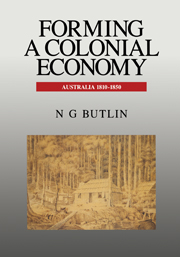Book contents
- Frontmatter
- Contents
- List of Tables
- List of Figures
- Acknowledgements
- Part I Forming an Economy
- Part II The Colonial Peopling of Australia: 1788–1850
- Part III Public Funding of Colonial Development: 1788–1850
- Part IV The Colonial Australian Economy 1810–1840—A Historical, Statistical and Analytical Account
- 11 Summary and Questions
- 12 Towards a Private Market Economy in Australia: 1810–40
- 13 Structural Adjustment and Development: 1810–40
- 14 Growth Performance: 1810–40
- 15 Instability and Economic Fluctuations with Special Reference to the Depression of the 1840s and Recovery
- Bibliography
- Appendixes
- Index
14 - Growth Performance: 1810–40
from Part IV - The Colonial Australian Economy 1810–1840—A Historical, Statistical and Analytical Account
Published online by Cambridge University Press: 04 August 2010
- Frontmatter
- Contents
- List of Tables
- List of Figures
- Acknowledgements
- Part I Forming an Economy
- Part II The Colonial Peopling of Australia: 1788–1850
- Part III Public Funding of Colonial Development: 1788–1850
- Part IV The Colonial Australian Economy 1810–1840—A Historical, Statistical and Analytical Account
- 11 Summary and Questions
- 12 Towards a Private Market Economy in Australia: 1810–40
- 13 Structural Adjustment and Development: 1810–40
- 14 Growth Performance: 1810–40
- 15 Instability and Economic Fluctuations with Special Reference to the Depression of the 1840s and Recovery
- Bibliography
- Appendixes
- Index
Summary
Introduction
What can we say of the Australian colonists' economic performance between 1810 and 1840? One achievement was the establishment of a reasonably flexibly operating market economy, despite convict origins and the absence of much in the way of political representation of the private sector in government decision making. Another was the development of a relatively complex structure of economic activities, combining natural resource use and urban-oriented industry, trade and services. A third achievement was the establishment of a substantial capability to export and to attract private capital from Britain. A fourth indicator of performance was the maintenance, with some instability, of extremely high rates of economic expansion or, alternatively, extremely high rates of labour absorption as convicts and, eventually, free immigrants flooded in.
These might all be taken as indicators of colonial ‘success’. Moreover, they might be more significant than the usual tests of performance in terms of productivity and standards of living, given that we are dealing with a foundation process. Nevertheless, these usual tests remain to be made. What levels of labour productivity, of gross domestic product per unit of factor input or of product per head of population were achieved? Did these levels grow over the thirty years and, if so, at what rate? Similarly, we might ask, in standard of living terms, what was the level and rate of growth of income, consumption or gross national expenditure per head of population?
- Type
- Chapter
- Information
- Forming a Colonial EconomyAustralia 1810–1850, pp. 197 - 222Publisher: Cambridge University PressPrint publication year: 1994



